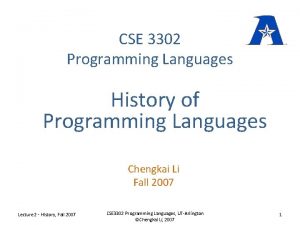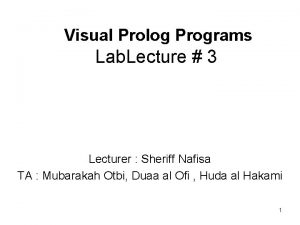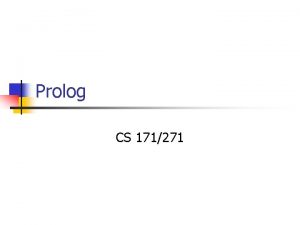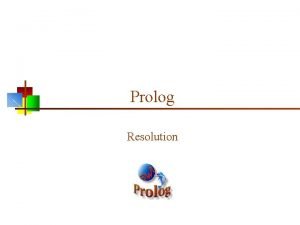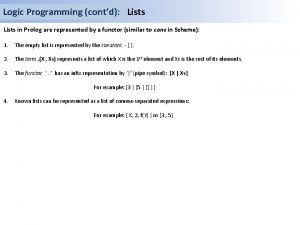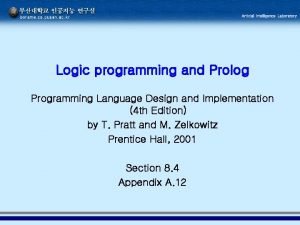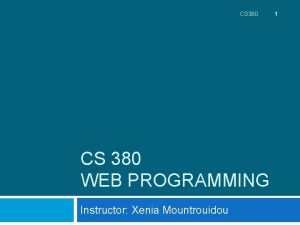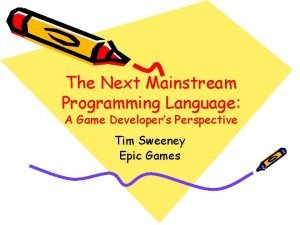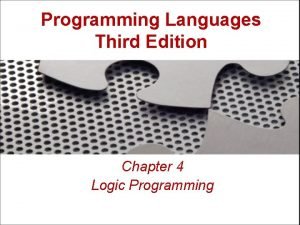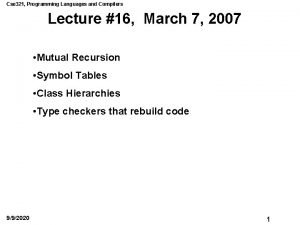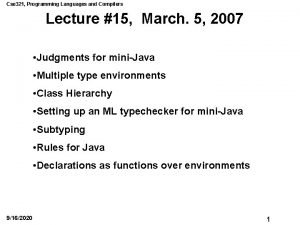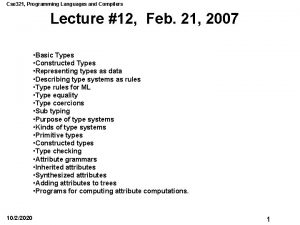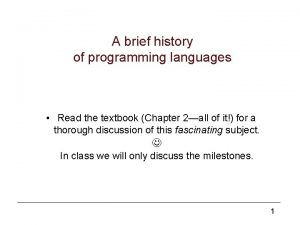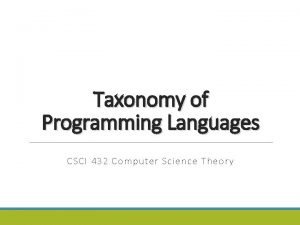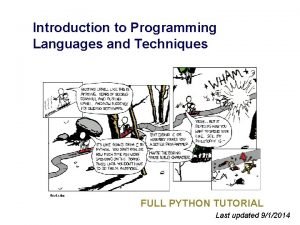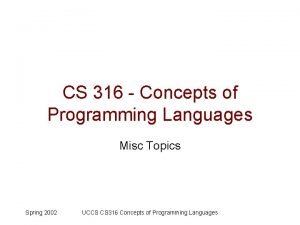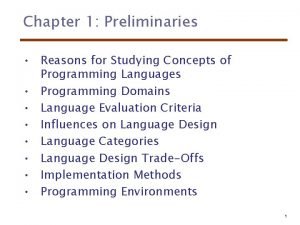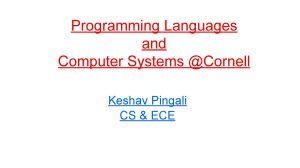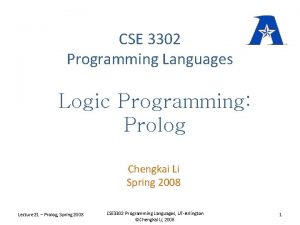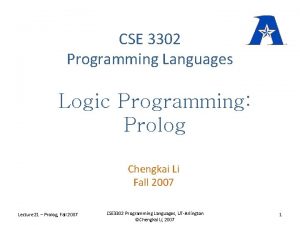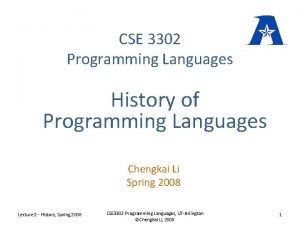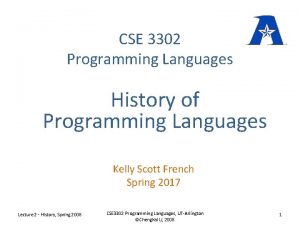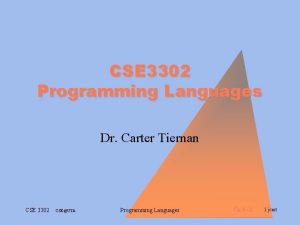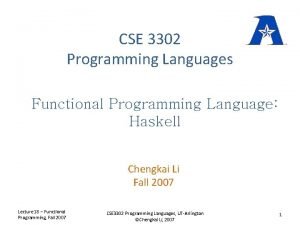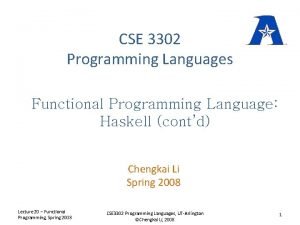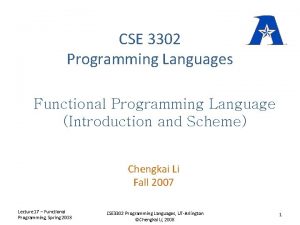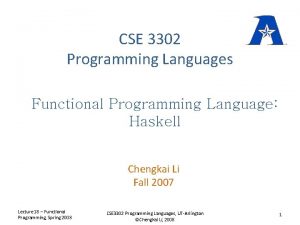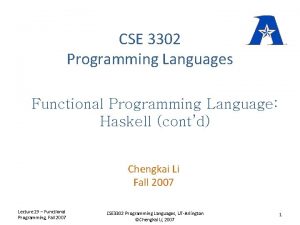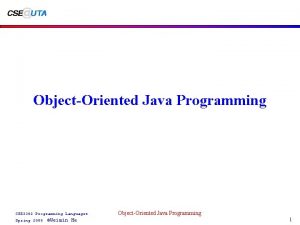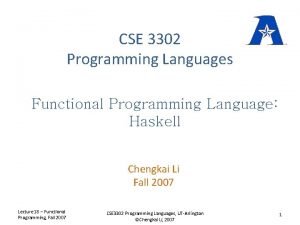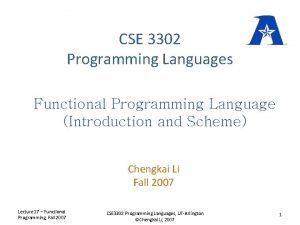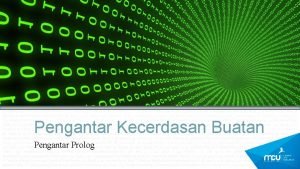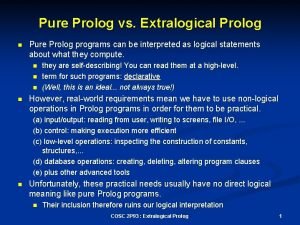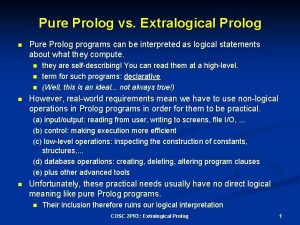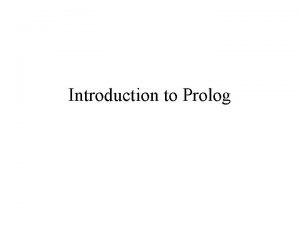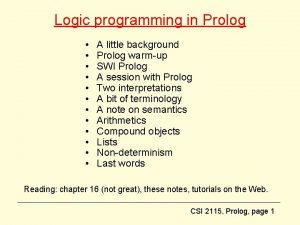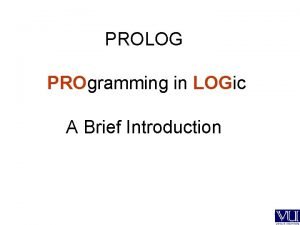CSE 3302 Programming Languages Logic Programming Prolog II











![List ? - [H|T]=[1, 2, 3]. H = 1, T = [2, 3] ? List ? - [H|T]=[1, 2, 3]. H = 1, T = [2, 3] ?](https://slidetodoc.com/presentation_image_h/1a68e60005c0bed99f6d07a90820dfbb/image-12.jpg)
![List Operations • Concatenation: ? - X = [0, 1|[2, 3, 4]]. X = List Operations • Concatenation: ? - X = [0, 1|[2, 3, 4]]. X =](https://slidetodoc.com/presentation_image_h/1a68e60005c0bed99f6d07a90820dfbb/image-13.jpg)
![Define List Operation Predicates • cons(X, Y, L) : - L = [X|Y]. ? Define List Operation Predicates • cons(X, Y, L) : - L = [X|Y]. ?](https://slidetodoc.com/presentation_image_h/1a68e60005c0bed99f6d07a90820dfbb/image-14.jpg)
![Define List Operation Predicates • append(X, Y, Z) : - X = [ ], Define List Operation Predicates • append(X, Y, Z) : - X = [ ],](https://slidetodoc.com/presentation_image_h/1a68e60005c0bed99f6d07a90820dfbb/image-15.jpg)
![• reverse([], []). reverse([H|T], L) : - reverse(T, L 1), append(L 1, [H], • reverse([], []). reverse([H|T], L) : - reverse(T, L 1), append(L 1, [H],](https://slidetodoc.com/presentation_image_h/1a68e60005c0bed99f6d07a90820dfbb/image-16.jpg)



















- Slides: 35

CSE 3302 Programming Languages Logic Programming: Prolog (II) Chengkai Li Fall 2007 Lecture 22 – Prolog (II), Fall 2007 CSE 3302 Programming Languages, UT-Arlington ©Chengkai Li, 2007 1

SWI-Prolog Lecture 22 – Prolog (II), Fall 2007 CSE 3302 Programming Languages, UT-Arlington ©Chengkai Li, 2007 2

Resources • Download: http: //www. swi-prolog. org/dl-stable. html • Documentation: (You don’t necessarily need to read. But good for reference when you have questions. ) http: //www. swi-prolog. org/dl-doc. html Menu “Help -> Online Manual” (HTML files in directory “doc”) ? -help(help). Lecture 22 – Prolog (II), Fall 2007 CSE 3302 Programming Languages, UT-Arlington ©Chengkai Li, 2007 3

Query Prompt • query prompt ? (Enter goals after “? -”) Example: ? - help(help). • Load a file with facts ? -[swi(‘myprogram/test. pl’)]. or ? -[swi(‘myprogram/test’)]. (myprogram must be a subdirectory in the swi-prolog program directory) Lecture 22 – Prolog (II), Fall 2007 CSE 3302 Programming Languages, UT-Arlington ©Chengkai Li, 2007 4

User Interaction ? - parent(bob, sam). Yes ? - parent(bob, jill). No ? - parent(bill, X), | parent(X, sam) |. No ? - parent(X, sam). X = jill ; X = bob Lecture 22 – Prolog (II), Fall 2007 (a query must end with. ) (can be proved) (cannot prove) (user can use multiple lines to write a query, using | ) (user typed ; to ask for more answers. ) CSE 3302 Programming Languages, UT-Arlington ©Chengkai Li, 2007 5

Debugging ? - trace, parent(X, sam). Call: (8) parent(_G 494, sam) ? creep Call: (9) mother(_G 494, sam) ? creep Exit: (9) mother(jill, sam) ? creep Exit: (8) parent(jill, sam) ? creep X = jill Redo: Call: Exit: ; (8) (9) (8) parent(_G 494, sam) father(bob, sam) ? parent(bob, sam) ? ? creep X = bob More details in section 2. 9 and 4. 2. 8 of the manual Lecture 22 – Prolog (II), Fall 2007 CSE 3302 Programming Languages, UT-Arlington ©Chengkai Li, 2007 6

Prolog Syntax Lecture 22 – Prolog (II), Fall 2007 CSE 3302 Programming Languages, UT-Arlington ©Chengkai Li, 2007 7

Basic Syntax <clause> <fact> <rule> <termlist> : : = <fact> <term> | <rule>. : - <termlist>. | <term> , <termlist> <term> : : = <variable> | <constant> | <compound-term> <constant> : : = <number> | <atom> <compound-term> : : = <atom> ( <termlist> ) Lecture 22 – Prolog (II), Fall 2007 CSE 3302 Programming Languages, UT-Arlington ©Chengkai Li, 2007 8

Prolog syntax • : - for , for and • Uppercase: variable Lowercase: other names (constants, atom (i. e. , name of predicate)) • Built-in predicates: read, write, nl (newline) =, is, <, >, =<, >=, /, *, +, -, mod, div (Note it is =<, not <=) Lecture 21 – Prolog, Fall 2007 CSE 3302 Programming Languages, UT-Arlington ©Chengkai Li, 2007 9

Arithmetic • Arithmetic operation can use prefix or infix notations. +(3, 4) 3+4 • Value is not immediately evaluated. ? - write(3+5). ? - X is 3+5. (is a predicate that evaluates 3+5) ? - 3+4 = 4+3. (these are two different terms) No. ? - X is 3+4, Y is 4+3, X = Y. (unification) X=7, Y=7 Lecture 22 – Prolog (II), Fall 2007 CSE 3302 Programming Languages, UT-Arlington ©Chengkai Li, 2007 10

Unification • The semantics of = is determined by unification, i. e. , = forces unification. (See unification algorithm in Page 556) ? - me = me. Yes ? - me = you. No ? - me = X. X = me ? - f(a, X) = f(Y, b). X = b, Y=a ? - f(X) = g(X). No Lecture 22 – Prolog (II), Fall 2007 CSE 3302 Programming Languages, UT-Arlington ©Chengkai Li, 2007 11
![List HT1 2 3 H 1 T 2 3 List ? - [H|T]=[1, 2, 3]. H = 1, T = [2, 3] ?](https://slidetodoc.com/presentation_image_h/1a68e60005c0bed99f6d07a90820dfbb/image-12.jpg)
List ? - [H|T]=[1, 2, 3]. H = 1, T = [2, 3] ? - [H 1, H 2|T]=[1, 2, 3]. H 1 = 1, H 2 = 2, T = [3] ? - [H 1, H 2, H 3|T]=[1, 2, 3, 4, 5]. H 1 = 1, H 2 = 2, H 3 = 3, T = [4, 5] Lecture 22 – Prolog (II), Fall 2007 CSE 3302 Programming Languages, UT-Arlington ©Chengkai Li, 2007 12
![List Operations Concatenation X 0 12 3 4 X List Operations • Concatenation: ? - X = [0, 1|[2, 3, 4]]. X =](https://slidetodoc.com/presentation_image_h/1a68e60005c0bed99f6d07a90820dfbb/image-13.jpg)
List Operations • Concatenation: ? - X = [0, 1|[2, 3, 4]]. X = [0, 1, 2, 3, 4] • Get elements, or tail : ? - [H 1, H 2|[3, 4]] = [0, 1|[2, 3, 4]] What do we get? Lecture 22 – Prolog (II), Fall 2007 CSE 3302 Programming Languages, UT-Arlington ©Chengkai Li, 2007 13
![Define List Operation Predicates consX Y L L XY Define List Operation Predicates • cons(X, Y, L) : - L = [X|Y]. ?](https://slidetodoc.com/presentation_image_h/1a68e60005c0bed99f6d07a90820dfbb/image-14.jpg)
Define List Operation Predicates • cons(X, Y, L) : - L = [X|Y]. ? - cons (0, [1, 2, 3], A). ? - cons (X, Y, [1, 2, 3]). • Rewrite cons: cons(X, Y, [X|Y]). Lecture 22 – Prolog (II), Fall 2007 CSE 3302 Programming Languages, UT-Arlington ©Chengkai Li, 2007 14
![Define List Operation Predicates appendX Y Z X Define List Operation Predicates • append(X, Y, Z) : - X = [ ],](https://slidetodoc.com/presentation_image_h/1a68e60005c0bed99f6d07a90820dfbb/image-15.jpg)
Define List Operation Predicates • append(X, Y, Z) : - X = [ ], Y=Z. append(X, Y, Z) : - X = [A|B], Z=[A|W], append(B, Y, W). • Another definition append([ ], Y, Y). append([A|B], Y, [A|W]) : - append(B, Y, W). ? - append(X, Y, [1, 2]). Lecture 22 – Prolog (II), Fall 2007 CSE 3302 Programming Languages, UT-Arlington ©Chengkai Li, 2007 15
![reverse reverseHT L reverseT L 1 appendL 1 H • reverse([], []). reverse([H|T], L) : - reverse(T, L 1), append(L 1, [H],](https://slidetodoc.com/presentation_image_h/1a68e60005c0bed99f6d07a90820dfbb/image-16.jpg)
• reverse([], []). reverse([H|T], L) : - reverse(T, L 1), append(L 1, [H], L). Lecture 22 – Prolog (II), Fall 2007 CSE 3302 Programming Languages, UT-Arlington ©Chengkai Li, 2007 16

Prolog’s Search Strategy Lecture 22 – Prolog (II), Fall 2007 CSE 3302 Programming Languages, UT-Arlington ©Chengkai Li, 2007 17

Resolution and Unification • Order matters: – The order to resolve subgoals. – The order to use clauses to resolve subgoals. • Thus programmers must know the orders used by the language implementations, in order to write efficient or even correct program. (Search Strategies) Lecture 22 – Prolog (II), Fall 2007 CSE 3302 Programming Languages, UT-Arlington ©Chengkai Li, 2007 18

Prolog’s Strategy • Depth-first search – The order to resolve subgoals. (left to right) – The order to use clauses to resolve subgoals. (top to bottom) • Backtrack: try another clause when it fails. Lecture 22 – Prolog (II), Fall 2007 CSE 3302 Programming Languages, UT-Arlington ©Chengkai Li, 2007 19

Example 1 • Facts: ancestor(X, Y) : - ancestor(X, Z), parent(Z, Y). ancestor(X, Y) : - parent(X, Y) : - mother(X, Y). parent(X, Y) : - father(X, Y). father(bill, jill). mother(jill, sam). father(bob, sam). • Queries: ? - ancestor(bill, sam). Lecture 22 – Prolog (II), Fall 2007 CSE 3302 Programming Languages, UT-Arlington ©Chengkai Li, 2007 20

Example 1 • Facts: ancestor(X, Y) : - ancestor(X, Z), parent(Z, Y). ancestor(X, Y) : - parent(X, Y) : - mother(X, Y). parent(X, Y) : - father(X, Y). father(bill, jill). mother(jill, sam). father(bob, sam). • Queries: : - ancestor(bill, sam). ancestor(X 1, Y 1) : - ancestor(X 1, Z 1), parent(Z 1, Y 1). X 1= bill, Y 1=sam : - ancestor(bill, Z 1), parent(Z 1, sam). Lecture 22 – Prolog (II), Fall 2007 CSE 3302 Programming Languages, UT-Arlington ©Chengkai Li, 2007 21

Example 1 • Facts: ancestor(X, Y) : - ancestor(X, Z), parent(Z, Y). ancestor(X, Y) : - parent(X, Y) : - mother(X, Y). parent(X, Y) : - father(X, Y). father(bill, jill). mother(jill, sam). father(bob, sam). • Queries: : - ancestor(bill, Z 1), parent(Z 1, sam). ancestor(X 2, Y 2) : - ancestor(X 2, Z 2), parent(Z 2, Y 2). X 2= bill, Y 2=Z 1 : - ancestor(bill, Z 2), parent(Z 2, Z 1), parent(Z 1, sam). Lecture 22 – Prolog (II), Fall 2007 CSE 3302 Programming Languages, UT-Arlington ©Chengkai Li, 2007 22

Example 1 • Facts: ancestor(X, Y) : - ancestor(X, Z), parent(Z, Y). ancestor(X, Y) : - parent(X, Y) : - mother(X, Y). parent(X, Y) : - father(X, Y). father(bill, jill). mother(jill, sam). father(bob, sam). • Queries: : - ancestor(bill, Z 2), parent(Z 2, Z 1), parent(Z 1, sam). ancestor(X 3, Y 3) : - ancestor(X 3, Z 3), parent(Z 3, Y 3). … Lecture 22 – Prolog (II), Fall 2007 CSE 3302 Programming Languages, UT-Arlington ©Chengkai Li, 2007 23

Example 1 ancestor(bill, sam) 2 ancestor(bill, Z 1), parent(Z 1, sam) 2 ancestor(bill, Z 2), parent(Z 2, Z 1) parent(Z 1, sam) 2 … Resulting in an infinite loop. Original order was bad Lecture 22 – Prolog (II), Fall 2007 CSE 3302 Programming Languages, UT-Arlington ©Chengkai Li, 2007 24

Example 2 • Facts: ancestor(X, Y) : - parent(X, Y). ancestor(X, Y) : - ancestor(X, Z), parent(Z, Y). parent(X, Y) : - mother(X, Y). parent(X, Y) : - father(X, Y). father(bill, jill). mother(jill, sam). father(bob, sam). 1 2 3 4 5 6 7 • Queries: ? - ancestor(bill, sam). What will happen? Note that we change the order of the first two clauses in facts. Lecture 22 – Prolog (II), Fall 2007 CSE 3302 Programming Languages, UT-Arlington ©Chengkai Li, 2007 25

Example 2 ancestor(bill, sam) 2 1 parent(bill, sam) 3 ancestor(bill, Z), parent(Z, sam) 1 4 mother(bill, sam) failure parent(bill, Z), parent(Z, sam) 3 4 mother(bill, Z), parent(Z, sam) failure father(bill, Z), parent(Z, sam) 5 parent(jill, sam) 3 mother(jill, sam) 6 success Lecture 22 – Prolog (II), Fall 2007 CSE 3302 Programming Languages, UT-Arlington ©Chengkai Li, 2007 26

Example 3 • Facts: ancestor(X, Y) : - parent(X, Y). ancestor(X, Y) : - ancestor(X, Z), parent(Z, Y). parent(X, Y) : - mother(X, Y). parent(X, Y) : - father(X, Y). father(bill, jill). mother(jill, sam). father(bob, sam). 1 2 3 4 5 6 7 • Queries: ? - ancestor(X, bob). Lecture 22 – Prolog (II), Fall 2007 CSE 3302 Programming Languages, UT-Arlington ©Chengkai Li, 2007 27

Example 3 ancestor(X, bob) 1 parent(X, bob) 2 ancestor(X, Z 1), parent(Z 1, bob) 1 parent(X, Z 1), parent(Z 1, bob) failure 2 failure ancestor(X, Z 2), parent(Z 2, Z 1), parent(Z 1, bob) … Resulting in an infinite loop. Original order was bad Lecture 22 – Prolog (II), Fall 2007 CSE 3302 Programming Languages, UT-Arlington ©Chengkai Li, 2007 28

Example 4 • Facts: ancestor(X, Y) : - parent(X, Y). ancestor(X, Y) : - parent(X, Z), ancestor(Z, Y). parent(X, Y) : - mother(X, Y). parent(X, Y) : - father(X, Y). father(bill, jill). mother(jill, sam). father(bob, sam). 1 2 3 4 5 6 7 • Queries: ? - ancestor(X, bob). What will happen? Note that we change the order of the two subgoals in clause (2). Lecture 22 – Prolog (II), Fall 2007 CSE 3302 Programming Languages, UT-Arlington ©Chengkai Li, 2007 29

Loops and Control: fail and cut (!) Lecture 22 – Prolog (II), Fall 2007 CSE 3302 Programming Languages, UT-Arlington ©Chengkai Li, 2007 30

fail • Loops: Enforce backtrack even when an answer is found (using built-in predicate fail) Lecture 22 – Prolog (II), Fall 2007 CSE 3302 Programming Languages, UT-Arlington ©Chengkai Li, 2007 31

Example • Print all solutions of appending. printpieces(L) : - append(X, Y, L), write(X), write(Y), nl, fail. ? - printpieces([1, 2]). [][1, 2] [1][2] [1, 2][] No Lecture 22 – Prolog (II), Fall 2007 CSE 3302 Programming Languages, UT-Arlington ©Chengkai Li, 2007 32

Example • num(0). num(X) : - num(Y), X is Y+1. ? - num(X). • writenum(I, J) : - num(X), I =< X, X =< J, write(X), nl, fail. ? - writenum(1, 10). Lecture 22 – Prolog (II), Fall 2007 CSE 3302 Programming Languages, UT-Arlington ©Chengkai Li, 2007 33

cut • Cut (using built-in predicate !) branches in the search tree (to avoid infinite loop). • “prunes” the search tree of all other siblings to the right of the node containing !. …, !, … Lecture 22 – Prolog (II), Fall 2007 CSE 3302 Programming Languages, UT-Arlington ©Chengkai Li, 2007 34

Example • writenum(I, J) : - num(X), I =< X, X =< J, write(X), nl, X = J, !, fail. ? - writenum(1, 10). Lecture 22 – Prolog (II), Fall 2007 CSE 3302 Programming Languages, UT-Arlington ©Chengkai Li, 2007 35
 Cse 3302
Cse 3302 Tw
Tw Cse 340 principles of programming languages
Cse 340 principles of programming languages Cse 340 principles of programming languages
Cse 340 principles of programming languages Domain in prolog
Domain in prolog Visual prolog vs swi-prolog
Visual prolog vs swi-prolog Propositional logic
Propositional logic Prolog programming
Prolog programming Prolog designed by
Prolog designed by Real-time systems and programming languages
Real-time systems and programming languages Elsa gunter uiuc
Elsa gunter uiuc Multithreading program in java
Multithreading program in java Programming languages levels
Programming languages levels Introduction to programming languages
Introduction to programming languages Plc
Plc Procedural programming languages
Procedural programming languages Imperative programming languages
Imperative programming languages Alternative programming languages
Alternative programming languages Strongly typed vs weakly typed
Strongly typed vs weakly typed Transmission programming languages
Transmission programming languages Int vs short
Int vs short Xenia programming languages
Xenia programming languages Advantages and disadvantages of programming languages
Advantages and disadvantages of programming languages Mainstream programming languages
Mainstream programming languages Programming languages
Programming languages Programming languages
Programming languages Programming languages
Programming languages Programming languages
Programming languages Attribute grammar in principles of programming languages
Attribute grammar in principles of programming languages Brief history of programming languages
Brief history of programming languages Lisp_q
Lisp_q Real-time systems and programming languages
Real-time systems and programming languages Xkcd software development
Xkcd software development If programming languages were cars
If programming languages were cars Reasons for studying concepts of programming languages
Reasons for studying concepts of programming languages Cornell programming languages
Cornell programming languages
